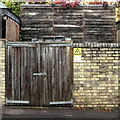1
Spot the student house - Magrath Avenue
Image: © Mr Ignavy
Taken: 14 Apr 2008
0.01 miles
2
Cromwellian ramparts
At the beginning of the English Civil War in 1642, Cambridge Castle was occupied by Parliamentary forces. The townsfolk mainly supported Oliver Cromwell, their local hero with his background in Huntingdon and Ely, but the University and Colleges were a hotbed of Royalism. Cromwell ordered the long-neglected fortifications to be beefed up as a defence against this threat, and so two earthen bastions of earth were hastily constructed. In the event no assaults took place and in 1647 the remains of the castle were slighted.
This embankment is what remains of the eastern earth wall which runs along the boundary of the Shire Hall site. The roof of a house in Magrath Avenue can be glimpsed through the vegetation.
Image: © Tiger
Taken: 1 Feb 2020
0.02 miles
3
Magrath Avenue substation, Cambridge
Substation L4464 5933U is operated by UK Power Networks
Image: © Tiger
Taken: 6 Oct 2015
0.02 miles
4
A May afternoon on Magrath Avenue
One of several pleasant Victorian streets north-west of the River Cam and not far from the centre of Cambridge.
Image: © John Sutton
Taken: 10 May 2021
0.02 miles
5
The Castle Mound, Castle Street
The former site of Cambridge Castle, now a grassy mound
Image: © Fractal Angel
Taken: 4 Jul 2007
0.03 miles
6
Access gates - Cripps Court (Magdalene College)
Image: © Mr Ignavy
Taken: 14 Apr 2008
0.04 miles
7
Shire Hall
Image: © N Chadwick
Taken: 10 Dec 2016
0.05 miles
8
Magrath Avenue
Off shoot linking with Hertford Street.
Image: © Mr Ignavy
Taken: 14 Apr 2008
0.05 miles
9
Castle End hostel
Viewed through the bare winter trees from the summit of the castle mound, the undergraduate hostel designed by David Roberts and completed in 1958 forms the largest of several buildings of various ages providing student accommodation for Clare College, on land between Castle Street and Chesterton Lane which has been in the College's possession since 1392. Castle End, though almost the newest addition to the site, perpetuates the name of a farm acquired in 1466.
Simon Bradley's 2014 revision of Pevsner's guide tells us that "Roberts introduced to Cambridge the sawtooth elevation, a device for giving privacy to individual rooms." He cites the work of the Swedish architect Anders Tengbom as an influence, though most British visitors will be reminded rather of Basil Spence's new cathedral at Coventry, completed a few years later. "But in spite of the jagged front and the monopitch roofs of every sawtooth, the building manages to look serene." Philip Booth and Nicholas Taylor, in their Guide to Cambridge New Architecture published in 1972, hail it as "a remarkable break, at this period, from the tradition of enclosed courts which had for too long dogged 20th-century architects building in Cambridge. It has ... an admirable simplicity of layout in the zizag pattern of rooms which leave room ... for washing facilities and gyp-rooms while giving the rooms themselves the optimum view. One weakness visible here occurs in later buildings of David Roberts ... insufficient clarity between loadbearing and non-loadbearing brickwork." A major renovation was undertaken in 2008, the half-centenary of the building's completion.
In Cambridge a gyp-room is a small kitchen equipped with a sink and basic cooking facilities, and usually shared between several student rooms in a college building.
Image: © Tiger
Taken: 11 Feb 2021
0.05 miles
10
Up Hertford Street
One of several pleasant Victorian streets north-west of the River Cam and not far from the centre of Cambridge.
Image: © John Sutton
Taken: 10 May 2021
0.05 miles

























